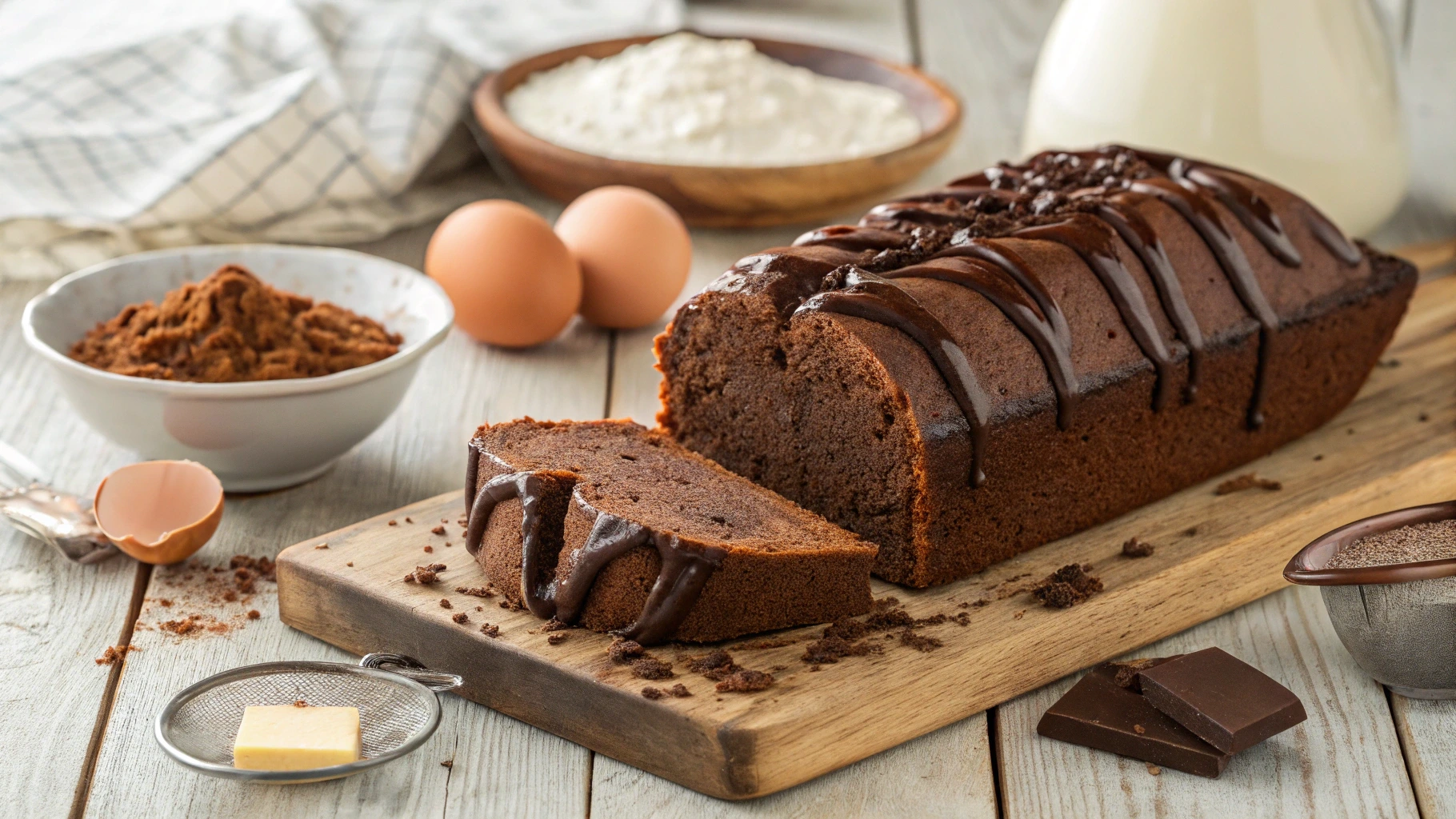introduction
If you’ve ever asked yourself, Why is my chocolate pound cake dry?, you’re not alone. This common baking challenge often leaves home bakers frustrated. A dry pound cake can result from various factors, such as incorrect measurements, overbaking, or an imbalance in ingredients.
Several factors contribute to dryness in cakes:
- Overmixing the batter introduces too much air, leading to a tough texture.
- Incorrect oven temperature can dry out the cake by cooking it too quickly.
- Imbalanced ingredient ratios—too much flour or not enough fat—will also impact moisture.
Fortunately, there are proven methods to ensure your chocolate pound cake stays moist and tender. By understanding the science behind baking and making minor adjustments, you can transform your results. Let’s explore the foundational elements of a moist chocolate pound cake and practical strategies to ensure success every time.
Understanding the Basics of a Moist Chocolate Pound Cake
The Role of Ingredients
Every ingredient in a chocolate pound cake has a specific function. For a moist cake:
- Butter and oils provide richness and create a tender crumb. Without enough fat, cakes can feel dry.
- Eggs add structure and moisture. Using the correct amount ensures balance.
- Dairy products like sour cream or buttermilk enhance flavor and lock in moisture.
The Importance of Ratios
Precision in baking is essential. A proper balance between wet and dry ingredients prevents dryness. Use these guidelines:
- Measure flour accurately by spooning it into the cup and leveling it off. Too much flour absorbs moisture.
- Maintain a wet-to-dry ingredient ratio of approximately 1:1 for a rich texture.
The Impact of Chocolate
The type of chocolate you choose influences moisture levels:
- Melted chocolate adds more fat than cocoa powder, creating a denser texture.
- Cocoa powder is drier, so it’s crucial to balance it with extra liquid or fat.
By understanding these basics, you can control the texture of your chocolate pound cake and avoid dryness.
Practical Tips for Achieving the Perfect Chocolate Pound Cake
Accurate Measuring Techniques
One of the simplest ways to avoid a dry chocolate pound cake is by accurately measuring ingredients. Common mistakes include scooping flour directly from the bag, which can result in excess flour. Instead:
- Use a digital scale for precise measurements.
- Always sift cocoa powder to eliminate clumps and distribute it evenly.
Room Temperature Ingredients
Ensure all ingredients, especially butter, eggs, and milk, are at room temperature before mixing. Cold ingredients don’t blend well, leading to uneven batter and dryness in spots.
Avoid Overmixing
Overmixing introduces too much air, which can lead to a dry, crumbly cake. To avoid this:
- Mix wet and dry ingredients just until combined.
- Use a spatula to fold in chocolate or other additions gently.
Monitor Baking Time
Dryness often occurs when cakes are overbaked. Follow these tips:
- Preheat the oven to the correct temperature and use an oven thermometer for accuracy.
- Start checking for doneness 5–10 minutes before the recommended time.
- Insert a toothpick in the center; it should come out with a few moist crumbs, not dry.
By following these strategies, you’ll consistently produce moist, delicious chocolate pound cakes.
How to Save a Dry Chocolate Pound Cake
Even if your chocolate pound cake turns out dry, don’t despair. There are numerous ways to rescue it or repurpose it into something equally delightful. From adding moisture to getting creative with new desserts, these techniques will ensure your hard work doesn’t go to waste.
Add Moisture with Syrups
One of the quickest and most effective methods to revive a dry cake is by adding a flavored syrup. This approach not only enhances the cake’s moisture but also infuses it with additional flavors, taking the dessert to the next level.
- To make a simple syrup, combine equal parts sugar and water in a saucepan. Stir over medium heat until the sugar dissolves completely. Allow the mixture to cool slightly before use.
- To elevate the flavor, consider adding extracts like vanilla, almond, or coffee. Citrus zest or a splash of liqueur (if alcohol-free is not a concern) can also add a unique touch.
- Use a pastry brush to generously coat the cake layers with the syrup. Allow it to soak in for a few minutes, and repeat as needed to achieve the desired moisture level. Be careful not to oversaturate, as this can make the cake overly soggy.
This technique works particularly well when combined with other solutions, such as frosting or glazes. The syrup provides a moist base that complements the other elements beautifully.
Use a Frosting or Glaze
Another effective way to mask dryness is by adding a rich, flavorful frosting or glaze. These toppings not only improve the cake’s texture but also provide a visually appealing finish.
- Chocolate Ganache: Combine heavy cream and dark chocolate in a 1:1 ratio. Heat the cream until steaming, then pour it over the chocolate. Stir until smooth and glossy. Spread the ganache over the cake, letting it drip over the sides for a professional look.
- Cream Cheese Frosting: Mix softened cream cheese with powdered sugar and a splash of vanilla. This tangy option pairs perfectly with chocolate, adding richness while balancing the sweetness.
- For a simpler alternative, create a glaze by mixing powdered sugar with milk or citrus juice. Drizzle it over the cake for a quick, elegant fix.
When applying frosting or glaze, ensure the cake is completely cooled to prevent the topping from melting. Layering frosting between slices can also enhance moisture throughout the cake.
Repurpose the Cake
If salvaging the cake in its current form doesn’t seem feasible, don’t give up. A dry chocolate pound cake can be transformed into entirely new desserts that are equally satisfying.
- Cake Pops: Crumble the dry cake into fine pieces in a large bowl. Mix in a few spoonfuls of frosting until the mixture holds its shape when pressed. Roll into bite-sized balls, insert sticks, and dip them into melted chocolate for a fun, portable treat.
- Trifles: Layer the crumbled cake with whipped cream, custard, and fresh fruit in a glass dish. The layers not only look stunning but also balance the dryness of the cake with creamy and juicy textures.
- Bread Pudding: Repurpose the cake by cutting it into cubes and using it in place of bread for a rich chocolate bread pudding. Combine the cake cubes with a mixture of eggs, milk, sugar, and cocoa powder, then bake until set.
Repurposing your cake not only saves it from being wasted but also allows you to get creative with entirely new desserts. Whether it’s cake pops for a party or a decadent trifle for a family gathering, there’s no shortage of delicious options.
Combining Techniques for Best Results
In many cases, combining these approaches will yield the best results. For example, a dry cake brushed with syrup and layered with frosting can taste as moist and delicious as a freshly baked one. Similarly, using syrup and crumbled cake for trifles creates a dessert that’s both inventive and satisfying.
By implementing these techniques, you can ensure that even a disappointing cake becomes a dessert worth sharing. With a little creativity, your dry chocolate pound cake can transform into a memorable and flavorful treat.
Frequently Asked Questions About Chocolate Pound Cake
What’s the Ideal Baking Time for a Chocolate Pound Cake?
The ideal baking time for a chocolate pound cake typically ranges from 50 to 70 minutes at 325°F (163°C). However, this depends on your specific oven, pan size, and recipe. For best results:
- Check for doneness early: Start testing the cake around the 45-minute mark to avoid overbaking.
- Look for visual clues: The edges should pull away slightly from the pan, and the top should appear set and slightly springy.
- Use a toothpick test: Insert it into the center; it should come out with a few moist crumbs, not wet batter or completely dry.
Overbaking is one of the most common causes of dryness in pound cakes, so keeping a close eye on the timing is crucial.
Can I Use Cocoa Powder Instead of Chocolate in the Recipe?
Yes, cocoa powder can replace chocolate, but adjustments are necessary to maintain moisture and flavor. Cocoa powder is naturally drier than melted chocolate, so balance the recipe with extra liquid or fat. Here’s how:
- Replace 1 ounce of chocolate with 3 tablespoons of cocoa powder and 1 tablespoon of butter or oil.
- If the recipe already uses cocoa powder, ensure additional moisture-rich ingredients like sour cream or buttermilk are included.
Cocoa powder’s bold flavor can enhance the chocolate taste, but without proper balancing, it may lead to dryness in the cake.
What Type of Butter Is Best for Chocolate Pound Cake?
High-quality unsalted butter is the best choice for chocolate pound cake. It allows you to control the salt content in your recipe, ensuring balanced flavors. Key tips:
- Use butter with a high fat content (European-style butter is a good option) for a richer, more tender crumb.
- Always bring the butter to room temperature before mixing. Softened butter blends evenly with sugar, creating a smooth, airy batter.
Avoid margarine or low-fat spreads, as they lack the richness needed for a moist and flavorful pound cake.
How Can I Test if My Cake is Done Without Drying It Out?
Testing a chocolate pound cake for doneness is a delicate process. To prevent overbaking and dryness:
- Toothpick test: Insert a toothpick into the center of the cake. It should come out with a few moist crumbs, not completely clean or covered in batter.
- Light touch test: Gently press the center of the cake with your finger. If it springs back, it’s done.
- Visual clues: The cake should have a slightly domed top, and the edges will begin to pull away from the pan.
Avoid opening the oven door frequently during baking, as this can lower the temperature and cause uneven cooking.
Why Does My Cake Crack on Top, and Is It Related to Dryness?
A cracked top is common in pound cakes and typically happens when:
- The oven temperature is too high, causing the top to set before the interior is fully baked.
- The batter is too thick, leading to uneven heat distribution.
While cracks are not directly related to dryness, they may indicate uneven baking, which can contribute to dry areas. To minimize cracking:
- Lower the oven temperature slightly and bake longer.
- Ensure the batter is smooth and well-mixed without overmixing.
A cracked top is not necessarily a flaw—it’s part of the rustic charm of pound cakes and doesn’t affect the flavor.
Can I Use Alternatives to Dairy for a Moist Cake?
Yes, you can use non-dairy ingredients to create a moist chocolate pound cake without sacrificing flavor or texture. Popular options include:
- Almond milk, oat milk, or soy milk: These can replace regular milk in a 1:1 ratio.
- Coconut cream: Adds richness similar to heavy cream.
- Plant-based yogurts: Provide the same tanginess and moisture as dairy-based sour cream or yogurt.
When using non-dairy alternatives, choose options with a higher fat content for better moisture retention. Additionally, check the sweetness of the substitute, as some non-dairy milks may alter the overall flavor.
Conclusion: The Secrets to a Perfect Chocolate Pound Cake Every Time
A moist chocolate pound cake is the result of careful preparation and attention to detail. To avoid asking Why is my chocolate pound cake dry?, focus on:
- Measuring ingredients accurately.
- Maintaining the correct balance of wet and dry components.
- Avoiding overmixing and overbaking.
Even if your cake doesn’t turn out as planned, there are ways to save or repurpose it. With these tips, you can confidently bake a chocolate pound cake that’s rich, tender, and full of flavor every time.

